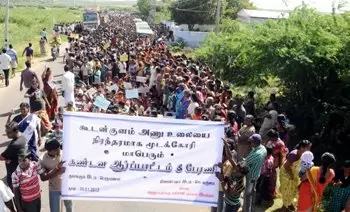Kudankulam’s fate will decide India’s energy policy

02-March-2012
Vol 3 | Issue 9
Almost a year ago, to be precise on the afternoon of 11 March, 2011, disaster struck Fukushima Daiichi nuclear power plant in Japan, the aftereffects of which are yet to be assessed fully.
The tragedy was sufficient for enlightened nations around the world, which had relied heavily on nuclear power for decades, to surreptitiously begin decommissioning nuclear power plants one after another.
 |
|
An anti-nuclear plant rally at Koodankulam in January, in which hundreds of women took part
|
In Japan 52 of the country’s 54 nuclear reactors have been shut down. In Germany, Chancellor Angela Merkel has said no more nuclear energy and announced phasing out of all existing nuclear power plants. The USA has not commissioned a single nuclear power plant in the last three decades.
While the world trend is to shift away from nuclear energy, India has chosen to tread the nuclear route to achieve self-sufficiency in power which others have abandoned to safeguard the health and well-being of future generations. Prime Minister Manmohan Singh cannot be so callous about the feelings of the people of the country.
That the UPA government has chosen to go in for 40,000 MW nuclear power in the next two decades has nothing to do with energy security but it is as per the dictates of World Bank and MNCs.
The cat was let out of the bag when Anil Kakodkar, former secretary to the Department of Atomic Energy, said in an interview with the Marathi daily Sakaal: “We also have to keep in mind the commercial interests of foreign countries like America, Russia and France with whom we made deals for nuclear projects.” Prime Minister should come clean and disclose for whose benefit he made these deals.
In Tamil Nadu, a popular agitation against the Russia-aided Koodankulam Nuclear Power Project has gathered momentum and the Union government has barred no holds to put it down and have its first 1,000 MW unit commissioned at the earliest.
When the Centre’s misinformation campaign about the project spearheaded by V Narayanasamy, minister of state in the PMO, failed, Manmohan Singh himself entered the fray with the startling allegation that NGOs funded by America and Sweden, bent on blocking India’s progress, were preventing the commissioning of the Koodankulam plant, without producing a shred of evidence.
Blaming “foreign hand” is an old trick resorted to by Indira Gandhi when she was the Prime Minister and Congressmen since have become adept at it. But no one is fooled.
Koodankulam is a test case for India. The project is closely intertwined with the government’s ambitious plans to set up a string of coastal nuclear power plants. Jaitapur in Maharashtra is the next in line to be taken up. As long as Koodankulam remains un-commissioned, the government will find it difficult to break ground for the Jaitapur project.
Through sheer cacophony about reactors being safe, and the urgent need for energy to tide over the acute power shortage Tamil Nadu is facing, the government hopes to create an atmosphere favourable for starting the Koodankulam plant.
The People’s Movement Against Nuclear Energy is largely of the fishermen community in and around Koodankulam and their primary concern is their livelihood.
Fishing is the only avocation they are familiar with and they have been engaged in it for generations.
In the event of commissioning the plant, the sea around it will be out of bounds for the fishermen for security reasons. The discharge of 7.2 billion liters of hot water into the sea every day from each reactor will adversely affect marine life in the area, rendering the poor fishermen to depend on the UPA government’s employment guarantee scheme. Who would willingly want to give up his sustainable living for the government’s will-o-the-wisp employment scheme?
For all the cacophony about Russian reactors being the safest, the site chosen for the Koodankulam plant is transected by sub-volcanic intrusive cutting into the granulite grade of metamorphic rocks.
The authorities had to spend a lot of money to strengthen the rocks by cement grouting. It is not safe to have a nuclear power plant on a cement grouted rock.
Places around Koodankulam have experienced small volcanic eruptions in 1998, 1999, 2001 and 2005.
Several researchers have found undersea volcanoes and volcano vents in the Gulf of Mannar, hardly 100 km from the plant. The presence of slumps in the Gulf of Mannar raises the possibility of submarine landslides causing near field mega tsunamis.
The spent fuel from Koodankulam is going to be transported by rail and road to Kalpakkam, near Chennai, for reprocessing, the nearest such facility.
The method of reprocessing nuclear fuel rods has always been defended as an appropriate method to dispose of dangerous nuclear waste. But reprocessing results in new waste, which is the most damaging industrial waste in the entire nuclear production chain.
It has to be stored in special storage pools made of high integrity concrete with additional stainless steel lining. The storage of high-level nuclear waste in tanks has resulted in catastrophic accidents in the past.
Kalpakkam has already proved to be a dangerous hot spot. In January 2003, a valve connecting a high-level radioactive waste tank and a low-level waste tank leaked, leading to radiation exposure of at least six employees and temporary closure of the Kalpakkam plant.
The struggle waged by the fishermen and other villagers in south Tamil Nadu stretches well beyond the Koodankulam nuclear power project.
No two nuclear accidents are alike. While we may be prepared to guard against a repeat of the Chernobyl or Fukushima type of disaster, the next nuclear accident will probably be caused by a different combination of factors and failures.
There are no reliable tools to predict what that combination will be and therefore one cannot be so confident, as Dr. Abdul Kalam seems to be, about the safety of the Koodankulam plant. The only fail-proof safety is to eschew nuclear energy, particularly since safer and cheaper alternative sources of energy are available.
Sam Rajappa is The Weekend Leader’s Consulting Editor














